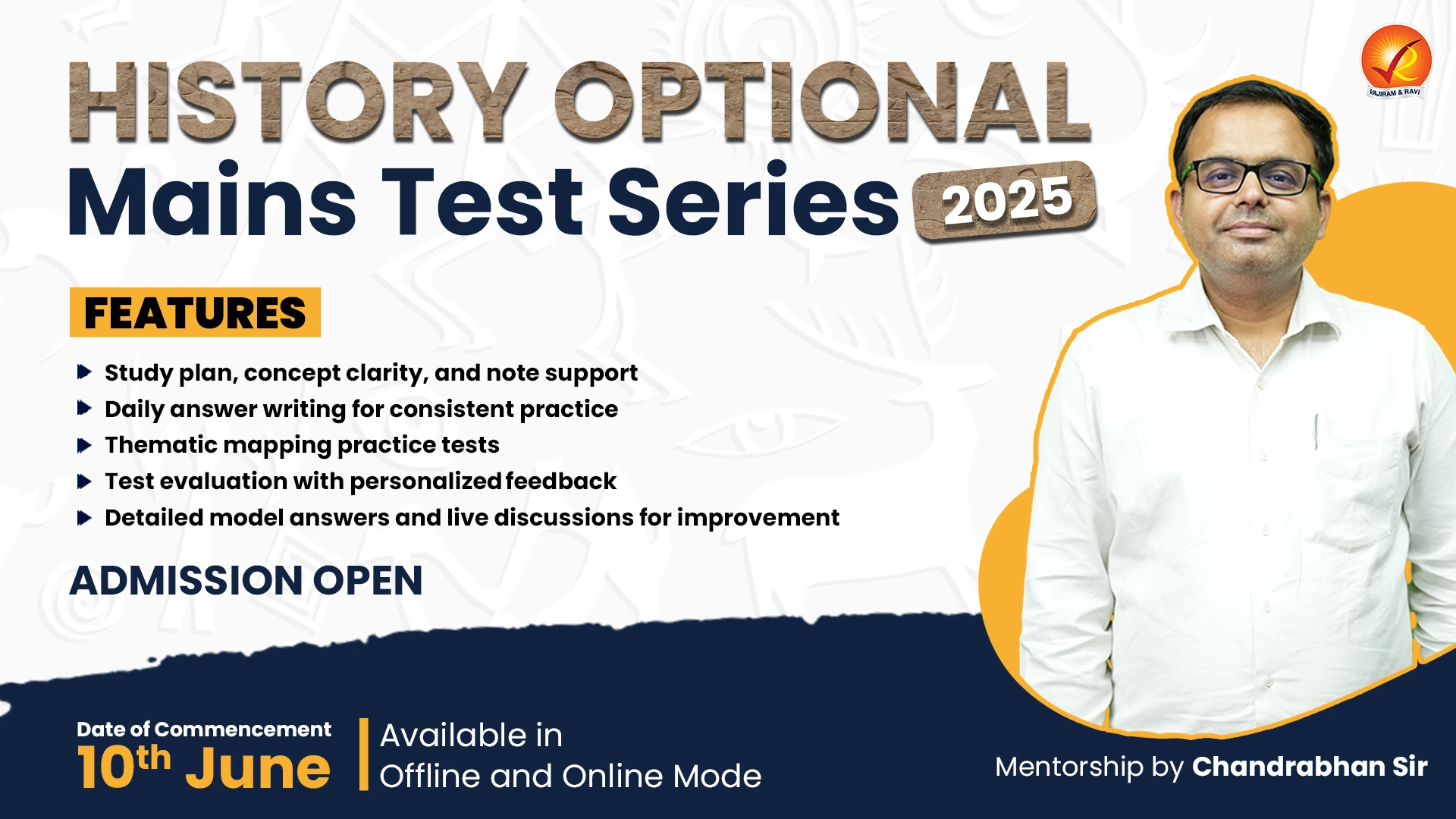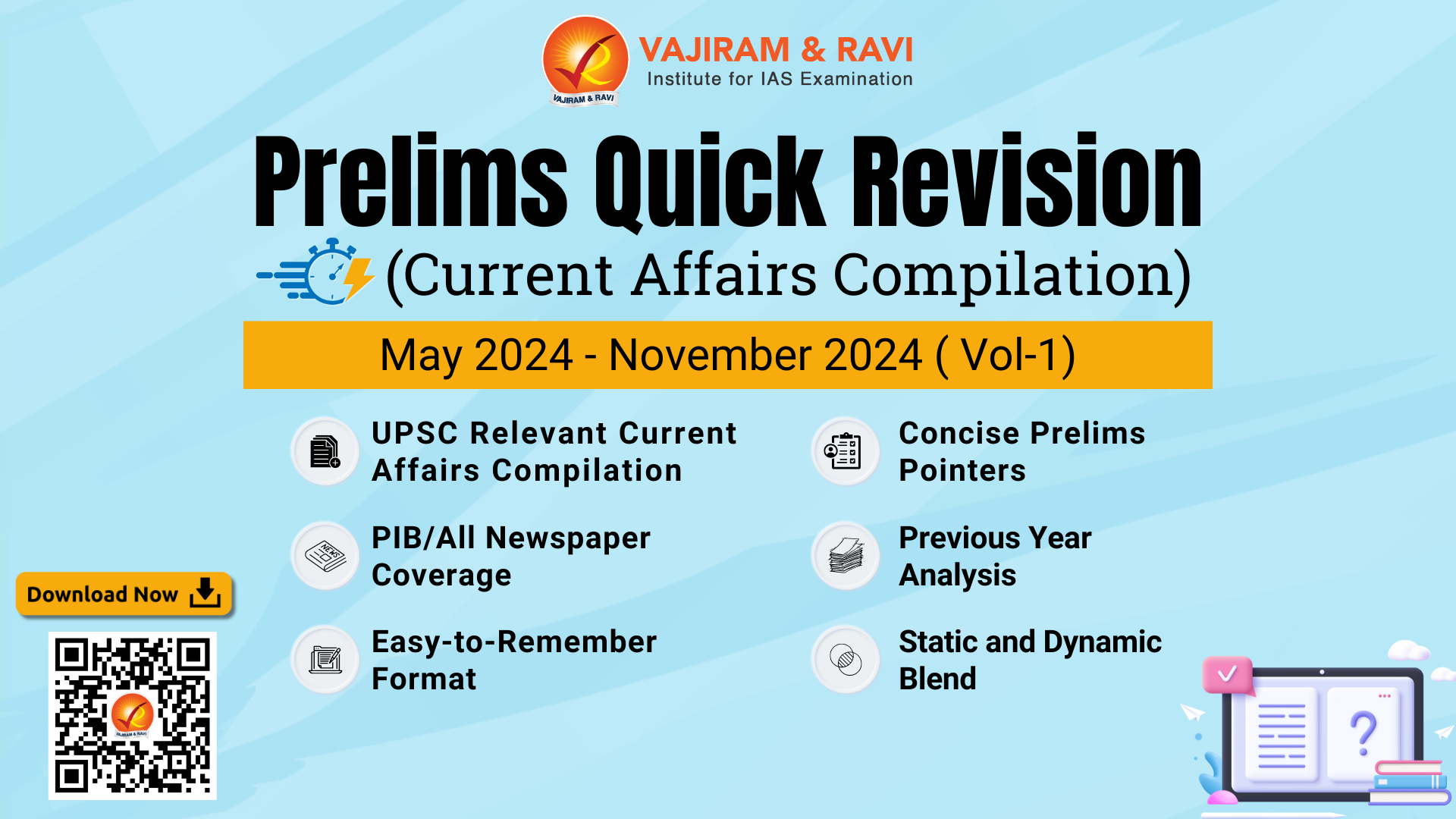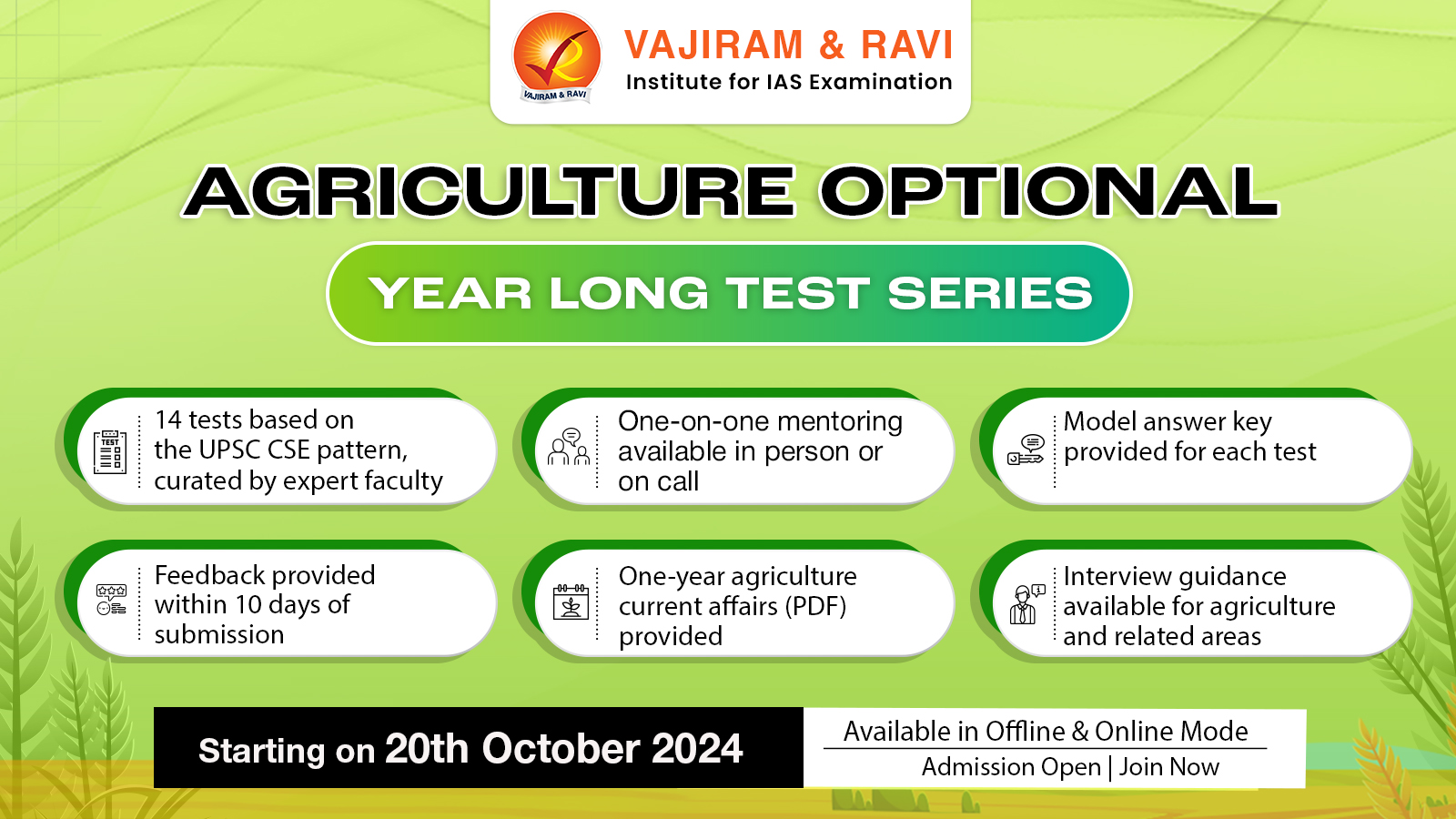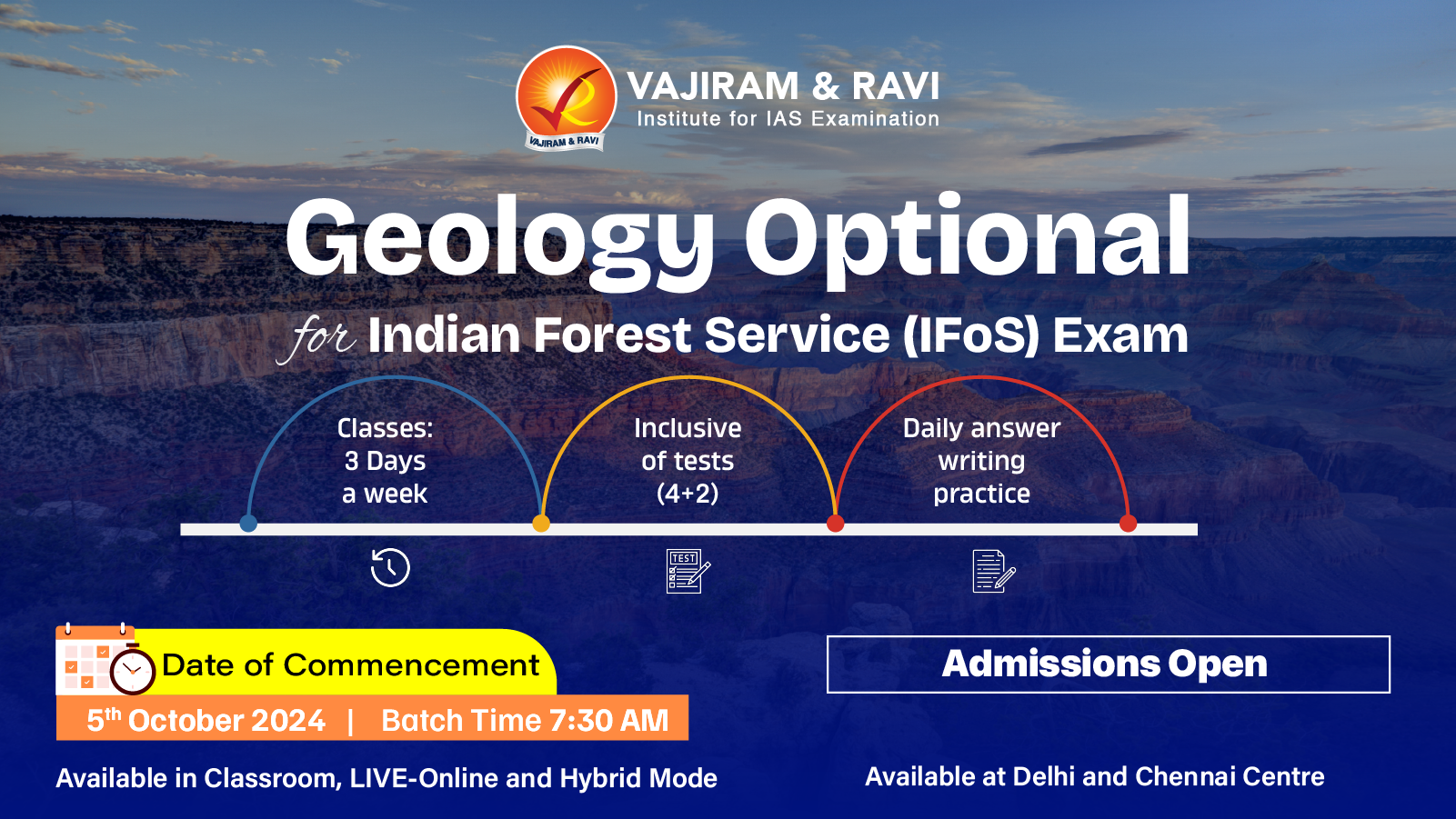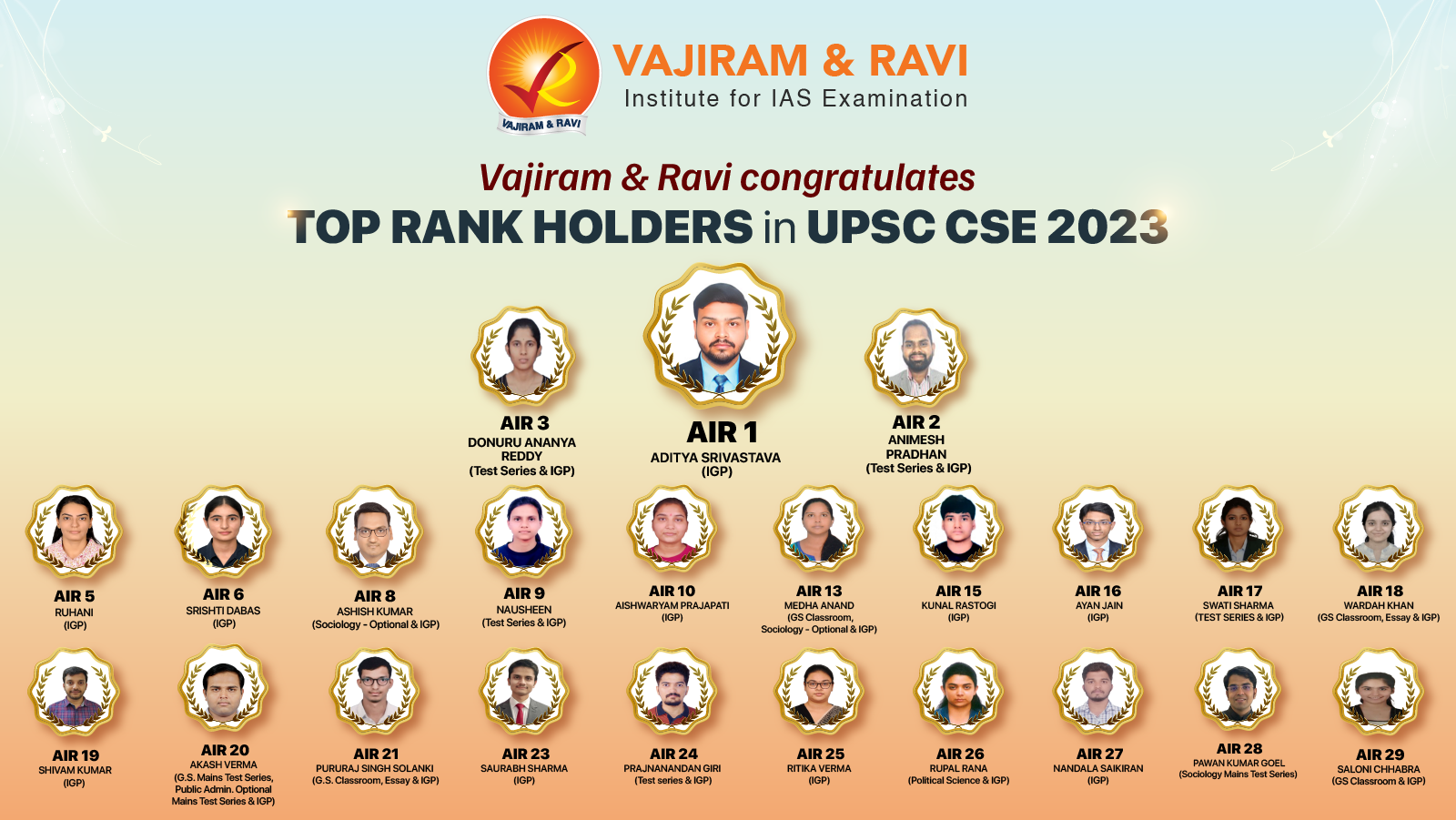Upcoming Mentoring Sessions
RMS - Economy 11 - Infrastructure
RMS - Art & Culture 3
RMS - Polity 7 - Parliament 3
RMS - Geography - Indian Physiography - 2
RMS - Economy 10 - Agriculture
RMS - Polity 7 - Parliament 2
RMS - Geography - Indian Physiography
RMS - Polity 7 - Parliament 1
RMS -Economy 9 - Fundamentals of Indian Economy
RMS - Geography 5 - Major Landforms
RMS - Art & Culture 2
RMS - Geography 4 - Volcanoes, Volcanic Landforms and Rocks
RMS - Polity 6 - Judiciary 2
RMS - Economy 8 - Trade and Important Government Schemes
RMS - Geography 3 - Evolution of Oceans and Continents
RMS - Economy 7 - Inflation
RMS - Polity 6 - Judiciary 1
RMS - Geography 2 - Basic Concepts of Universe & Earth Interior
RMS - Art & Culture 1
RMS - Economy 6 - Balance of Payment
RMS - Geography 1 - Geomorphic Processes
RMS - Polity 5 - Constitutional & Non-Constitutional Bodies
Mentoring Session - UPSC Form Filling
RMS - Economy 5 - Financial Markets
RMS - Polity 4 - Fundamental Rights - P3
RMS - Economy 4 - Fiscal Policy and Budgeting
RMS - History 2 - From 1765 to 1858 - P2
RMS - Polity 4 - Fundamental Rights - P2
RMS - Economy 3 - Taxation
RMS - Polity 4 - Fundamental Rights-P1
RMS - History 1 - European Penetration to Battle of Buxar
RMS - Economy 2 - Money & Banking - P2
Mentoring Session (2024 - 25) - How to Write an ESSAY?
Social Issues Doubts and Mentoring Session
Ethics & Essay Doubts and Mentoring Session
Geography & Environment Doubts and Mentoring Session
History Doubts and Mentoring Session
Economy & Agriculture Doubts and Mentoring Session
Online Orientation Session
How to Read Newspaper and Make Notes?
Mains Support Programme 2025-(2)
Mains Support Programme 2025- (1)
Polity & International Relations Doubts and Mentoring Session
Mentoring Sessions (2024-25) - How to DO REVISION?
RMS - Polity - Parliament 3
Mentoring Sessions (2025-26) - How to Start Preparation?
RMS - Geography - World Mapping
RMS - Polity - Parliament 2
Prelims 2024 Strategy Session
RMS - Polity 3 - Union & its Territories and Citizenship
RMS - Geography - Major Landforms
RMS - Polity 2 - Preamble
RMS - Economy 2 - Money & Banking - P1
Mentoring Session (2024-25) - How to Make Notes?
RMS - Polity 1 - Constitution & its Salient Features
General Mentoring Session (GMS )
RMS - Modern History - Constitutional Developments - Important Acts in British India
Mentoring Session (2025-26) - How to write an Answer?
RMS - Economy 1 - Fundamentals of Economy and NIA
Current Affairs
July 5, 2025
Reserve Bank of India (Pre-payment Charges on Loans) Directions, 2025
The RBI recently announced Reserve Bank of India (Pre-payment Charges on Loans) Directions, 2025, prohibiting banks and other regulated lenders from charging prepayment penalties on floating-rate loans availed by individuals for non-business purposes.

About Reserve Bank of India (Pre-payment Charges on Loans) Directions, 2025:
- It prohibited banks and other regulated lenders from charging prepayment penalties on floating-rate loans availed by individuals for non-business purposes.
- It benefits borrowers of home loans and other floating-rate loans, allowing them to repay loans ahead of schedule without additional fees.
- These new rules will be enforced on all loans which are sanctioned or renewed on or after January 1, 2026.
- The directive will apply to commercial banks and regulated entities (REs) such as NBFCs, excluding specific banks like Small Finance Banks and Regional Rural Banks unless they issue loans up to Rs 50 lakh.
- The exemption applies regardless of whether the loan is repaid fully or partially, the source of funds, or the presence of co-obligants.
- It also includes dual and special rate loans if they are on a floating rate at the time of repayment.
- No minimum lock-in period is required.
- For loans not covered under this rule, lenders must disclose any prepayment charges in the sanction letter, loan agreement, and Key Facts Statement.
- Should a bank fail to include this information, it cannot levy any prepayment charge.
Economy
Current Affairs
July 5, 2025
Asteroid Terrestrial-impact Last Alert System (ATLAS)
A comet, officially designated 3I/ATLAS, originating from outside our solar system has been recently spotted by the Asteroid Terrestrial-impact Last Alert System (ATLAS) in Chile.

About Asteroid Terrestrial-impact Last Alert System (ATLAS):
- It is an asteroid impact early warning system developed by the University of Hawaii and funded by NASA.
- It consists of four telescopes (2 in Hawaii, 1 in Chile, 1 in South Africa), which automatically scan the whole sky several times every night looking for moving objects.
- Although the ATLAS system is also used to identify dwarf planets, supernova explosions, and life exposure remanence from a star being absorbed by a supermassive black hole in a distant galaxy, the main purpose of this project is to search for large “killer asteroids” that may have a tremendous impact on life on earth.
- ATLAS will provide a warning time depending on the size of the asteroid -- larger asteroids can be detected further from Earth.
- ATLAS will see a small (~20 meter) asteroid several days out, and a 100 meter asteroid several weeks out.
- The system is specially designed to detect objects that approach very close to Earth – closer than the distance to the Moon, about 240,000 miles or 384,000 kilometers away.
Science & Tech
Current Affairs
July 5, 2025
Mount Shinmoedake
Japan's Mount Shinmoedake, a volcano in the Kirishima mountain range on Kyushu Island, erupted recently, sending a towering ash plume into the sky.
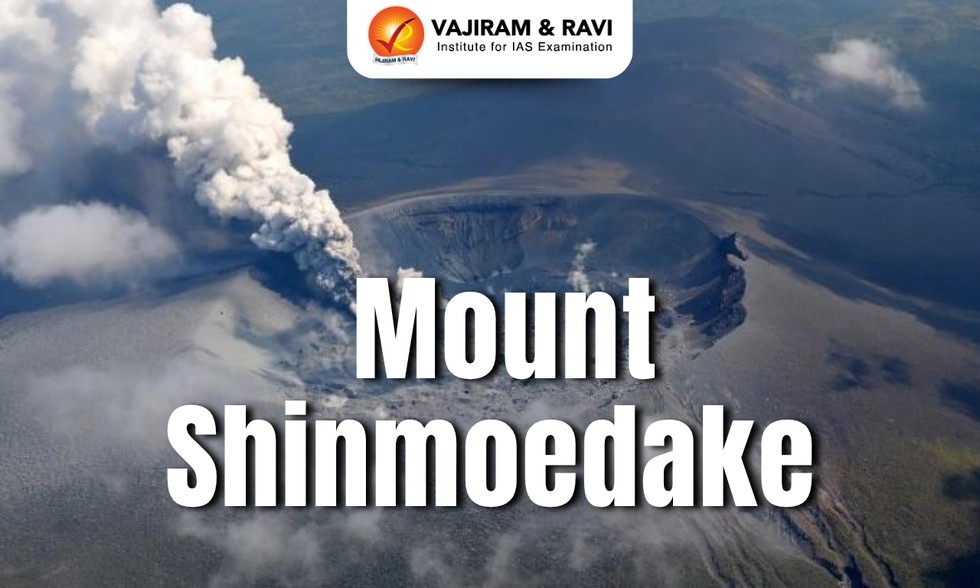
About Mount Shinmoedake:
- It is an active stratovolcano located on Kyushu Island, Japan, within the Kirishima mountain range.
- It rises 1420.8 meters above sea level as part of the volcanic complex in Kagoshima Prefecture, displaying frequent eruption patterns and geological formations.
- Recorded eruptions of Shinmoedake started in 1716. Since then there have been eruptions scattered across all the years to the present day.
- It gained international fame as one of the filming locations for the 1967 James Bond movie "You Only Live Twice".
What is a Stratovolcano?
- It is a tall, steep, and cone-shaped type of volcano.
- Unlike flat shield volcanoes, they have higher peaks.
- They are typically found above subduction zones, and they are often part of large volcanically active regions, such as the Ring of Fire that frames much of the Pacific Ocean.
- They are usually about half-half lava and pyroclastic material, and the layering of these products gives them their other common name of composite volcanoes.
- At the peak, stratovolcanoes usually have a small crater. The crater may be filled with water or ice, or it may contain a volcanic dome during a period of relative inactivity.
- Stratovolcanoes comprise the largest percentage (~60%) of the Earth’s individual volcanoes, and most are characterized by eruptions of andesite and dacite, lavas that are cooler and more viscous than basalt.
- These more viscous lavas allow gas pressures to build up to high levels. Therefore, these volcanoes often suffer explosive eruptions.
Geography
Current Affairs
July 5, 2025
Alaknanda River
Heavy rains in Rudraprayag, Uttarakhand have triggered a surge in the water level of the Alaknanda River, creating a flood-like situation in the region.
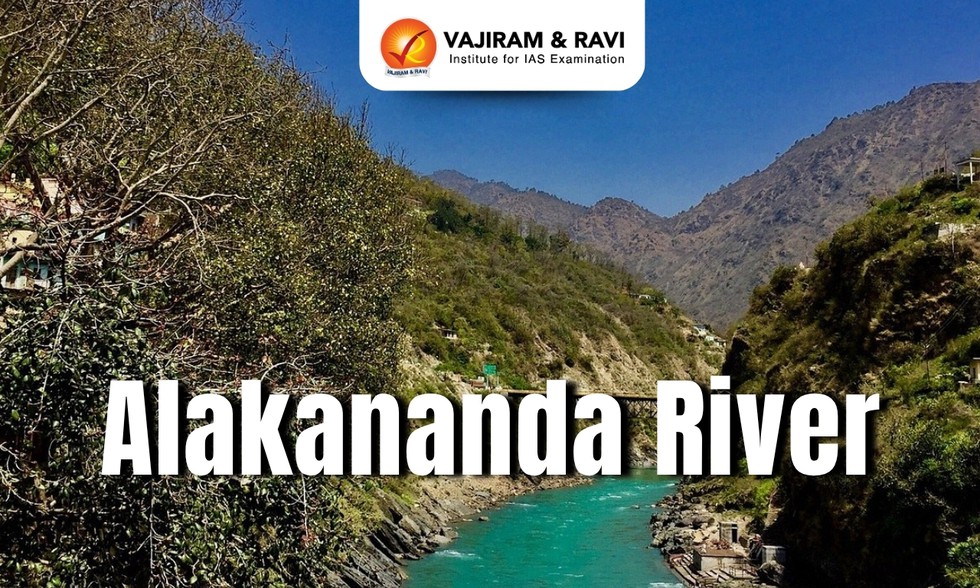
About Alaknanda River:
- It is a Himalayan river in the state of Uttarakhand.
- It is one of the two main headstreams of the Ganges River, the other being the Bhagirathi River.
- It originates from the meltwaters of the Satopanth and Bhagirath Kharak glaciers in the Garhwal Himalayas of Uttarakhand.
- The river is joined by many tributaries in Uttarakhand.
- Five of the tributaries are considered major, and their points of confluence are also worshipped. The five holy confluences in the Garhwal Himalayas are also known as Panch Prayag. They are listed below:
- Vishnuprayag: Alaknanda meets Dhauliganga River
- Nandprayag: Alaknanda meets Nandakini River
- Karnaprayag: Alaknanda meets Pindar River
- Rudraprayag: Alaknanda meets Mandakini River
- Devprayag: Alaknanda meets Bhagirathi. This is the most revered confluence, as it is here when the surging water coming from the mountains is finally called the Ganga.
- At the time of the formation of Ganga, Alaknanda’s contribution to the flow is much larger than that of Bhagirathi.
- From its source till its union with Bhagirathi, Alaknanda travels for 190 km (approx.).
- Along the banks of the Alaknanda are numerous important pilgrimage sites such as Badrinath, Hemkund Sahib, and Joshimath.
- The Alaknanda River valley is a significant part of the Char Dham Yatra, a pilgrimage circuit that encompasses four sacred sites—Badrinath, Kedarnath, Gangotri, and Yamunotri.
- There are several hydel projects in the basin, which include the Alaknanda (Badrinath), Lata Tapovan, Devsari Dam, Nandprayag Langasu, and Vishnugad Pipalkoti, to name a few.
Geography
Current Affairs
July 5, 2025
Key Facts about Girmitiyas
The Prime Minister recently said the descendants of Girmitiyas are no longer defined by struggle but by their "success, service, and values".

About Girmitiyas:
- “Girmitiyas” were Indian indentured labourers who left India in the mid to late 19th century to work in British colonies, where many eventually settled.
- The word ‘girmitiya’ is etymologically derived from ‘girmit’, meaning ‘agreement’.
- Indians then pronounced ‘agreement’ as ‘girmit’, so indentured labourers who were transported to work in places like Fiji and Mauritius, became known as ‘girmitiyas’.
- However, the agreements weren’t all that fair.
- Indian labourers signed indentureship contracts with the British in hopes of higher wages and better employment opportunities.
- However, they made long treacherous journeys on old slave ships and upon reaching foreign lands, were made to live in slave barracks, were paid very little, and did not have access to proper legal frameworks under which they could get grievances redressed.
- Though girmitiyas were not technically slaves in the eyes of the law, they were subjected to a practice known as “blackbirding”, which involved deceiving or tricking people to work as slaves or poorly paid labourers in countries far away from their native land.
- Despite the unfortunate history of girmitiyas, their descendants have prospered in their respective countries, some having held “high-level” government positions and others having achieved success in business and arts.
Geography
Current Affairs
July 5, 2025
Bukkapatna Chinkara Wildlife Sanctuary
Recently, 300 acres of encroached forest land was cleared in Bukkapatna Chinkara Wildlife Sanctuary.
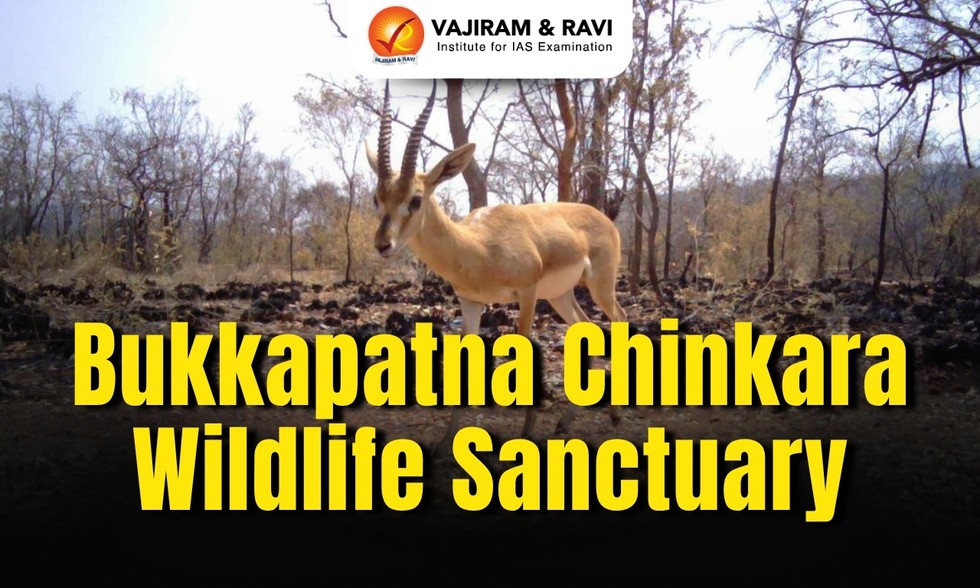
About Bukkapatna Chinkara Wildlife Sanctuary:
- Location: It is located in Tumakuru district of
- This protected area was declared as a sanctuary in 2019 and is dedicated for protection and conservation of the Indian Gazelle which are also known as Chinkaras.
- It is the second Chinkara (Gazelle bennetti) sanctuary in Karnataka after notifying a similar sanctuary at Yadahalli in Bagalkot district of North Karnataka in 2016.
- Vegetation: This is a rich habitat for various species inhabiting the wood savannahs – where a lot of grasses grow and are sparsely interspersed with native tree species.
- Fauna: Other than Chinkaras, four horned antelopes, black bucks, sloth bears, leopards and other species inhabit this sanctuary.
- Flora: The main trees found in the area are Hardwickia binata (Anjan), P. emblica of Phyllanthaceae family (Amla), Boswellia Serrata (Shallaki), Tamarindus Indica (Imli), Pterocarpus Marsupium (Bijaka), Anogeissus latifolia (Dhaura), Shoerea talura and Terminalia tementose.
Environment
Current Affairs
July 5, 2025
Sarcoma
Every year in July, Sarcoma Awareness Month brings attention to a group of rare and often misunderstood cancers.
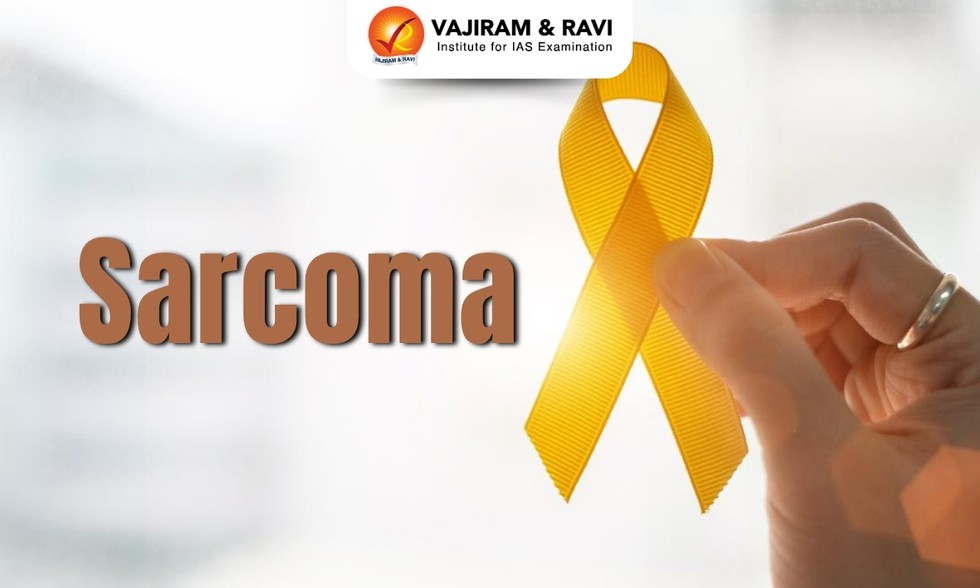
About Sarcoma:
- Sarcoma is not just one disease, it is a family of cancers that originate in the bones and soft tissues such as fat, muscles, blood vessels, nerves, and deep skin tissues.
- Types of sarcomas
- Sarcomas are primarily divided into two main categories: soft tissue sarcomas and bone sarcomas.
- There are more than 70 subtypes, and this complicates both diagnosis and treatment.
- Examples of common soft tissue sarcomas include liposarcoma (originating from fat tissue), leiomyosarcoma (arising from smooth muscle), and angiosarcoma (developing from blood vessels). Bone sarcomas consist of osteosarcoma (frequently seen in children and young adults), Ewing sarcoma, and chondrosarcoma.
- A sarcoma typically appears as a painless lump or swelling that may increase in size over time.
- Since these signs can be confused with non-cancerous conditions such as cysts or injuries, diagnosis is often postponed, permitting the cancer to advance.
- It can affect anyone, certain risk factors increase susceptibility.
- Risk factors of Sarcoma includes:
- Genetic conditions such as Li-Fraumeni syndrome or neurofibromatosis; previous radiation therapy, especially in areas later affected by sarcoma;
- Chemical exposure to agents like vinyl chloride or dioxins; chronic swelling (lymphedema) or certain inherited syndromes.
- Children and young adults are more frequently diagnosed with bone sarcomas, while soft tissue sarcomas are more common in older adults.
- Prevalence: Sarcomas account for only about 1% of all adult cancers and 15% of paediatric cancers, their impact is profound, especially due to limited awareness and late diagnosis.
Science & Tech
Current Affairs
July 5, 2025
Polar Anticyclone
Recently, Chile and Argentina ranked among the coldest places on Earth, outside the polar regions as polar anticyclone grips region.
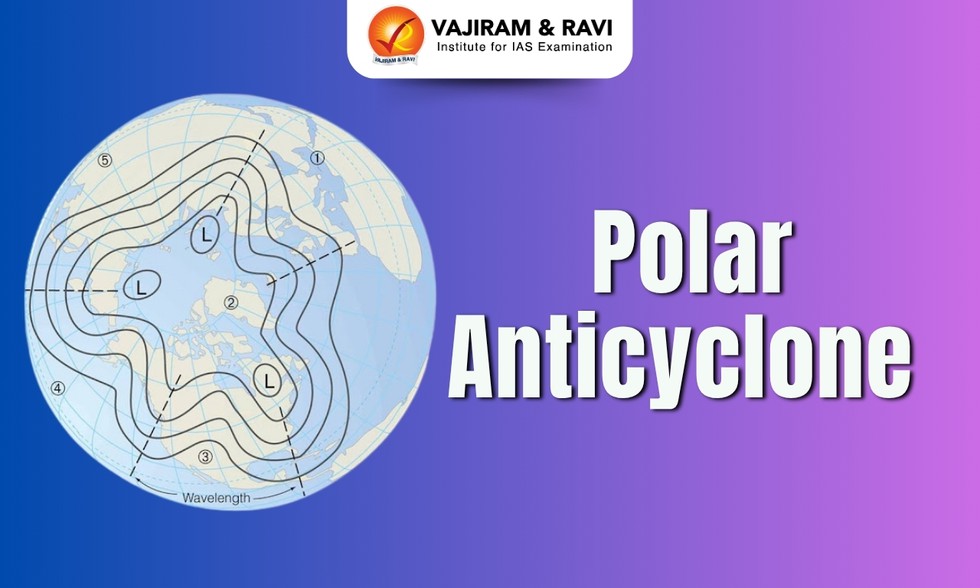
About Polar Anticyclone:
- It is a wind system associated with a region in which high atmospheric pressure develops over or in the vicinity of the poles.
- The polar anticyclone is strongest in the cold season of the year.
- Examples: The Siberian anticyclone is an example of a polar anticyclone, as is the high-pressure area that forms over Canada and Alaska during the winter.
- Formation of Polar anticyclones
- Polar anticyclones are created by the cooling of surface layers of air.
- This cooling causes the air near the surface to become denser and, at the same time, causes an inflow of air at high levels to replace the denser, sinking air.
- These processes increase the mass of air above the surface, thus creating the anticyclone. The weather within the central regions of these anticyclones is typically clear and quite cold. The strength of polar anticyclones is greatest near the Earth’s surface.
- It frequently migrate eastward and equator ward in the winter season, bringing cold waves to warmer latitudes. In the summer they provide cool, dry weather as they move toward the Equator.
- The boundary separating the cold polar air from the warmer air is called the polar front, and along this frontal surface the extratropical cyclones, or wave cyclones, form. See also front.
Geography
Current Affairs
July 5, 2025
Ham Radio
Indian astronaut Shubhanshu Shukla interacted with the country’s students using a ham radio from the International Space Station (ISS).

About Ham Radio:
- Amateur radio, popularly known as ham radio, is a licensed radio service that relies on radio waves for establishing communication.
- Ham radio service is largely deployed for educational and knowledge purposes, for emergency or SOS communication.
- Using a dedicated frequency, a transceiver and an antenna, communication can be set up between two licensed hams by trained ham operators.
- The communication can be hyper-local, global, and in space. In India, any individual above the age of 12 is permitted to operate a ham radio.
- In India, the Ministry of Electronics and Information Technology issues these licences.
- Even though the technology to establish communications has advanced, the radio remains one of the most reliable and stable modes of communication.
- It is effective and an alternate medium of establishing communication.
- Previously, there have been instances when ham radio came to the rescue when traditional communication lines broke down, either due to man-made scenarios (like wars) or natural disasters such as earthquakes, cyclones, and floods.
- In India, ham radio was used for making emergency contacts during the Bhuj earthquake (2001), the Indian Ocean tsunami (2004), the floods of Uttarakhand (2013) and more such calamities.
Science & Tech
Current Affairs
July 5, 2025
BHARAT Initiative
The Indian Institute of Science (IISc), Bengaluru, launched a large-scale study called BHARAT.
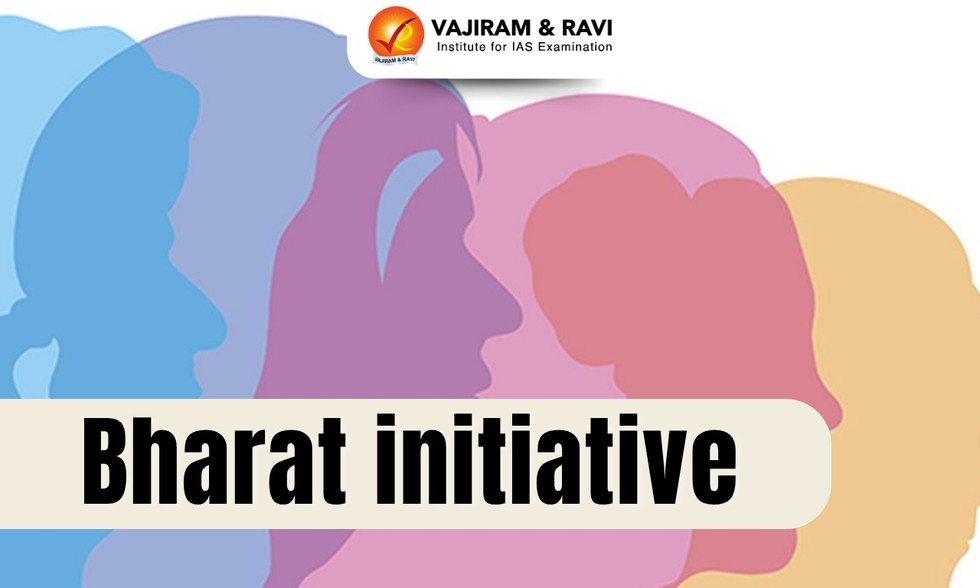
About BHARAT Initiative:
- BHARAT is a short for ‘Biomarkers of Healthy Aging, Resilience, Adversity, and Transitions’, as part of its Longevity India Program.
- The study aims to map the physiological, molecular, and environmental indicators that drive ageing in the Indian population.
- Under this initiative researchers are building India's first comprehensive aging database through:
- Multiparametric analysis
- Advanced clinical assessment
- Lifestyle and environmental factors
- Comprehensive biomarker discovery
- It is identifying biomarkers for healthy ageing and also building the Bharat Baseline — a reliable reference for what is normal in the Indian population.
- Its database will include genomic biomarkers (like mutations linked to disease susceptibility), proteomic and metabolic indicators (reflecting biological pathways and metabolic health), and environmental and lifestyle factors.
- It will challenge the western values for cholesterol, vitamin D, or B12 may label many Indians as deficient.
What are Biomarkers?
- Biomarkers, short for ‘Biological Markers’ are a physical, chemical, or biological characteristic that is present in the human body, and measurable too.
- The WHO defines a biomarker as “any measurement reflecting an interaction between a biological system and a potential hazard, which may be chemical, physical, or biological. The measured response may be functional and physiological, biochemical at the cellular level, or a molecular interaction”.
- They are indispensable in diagnosing disease, prescribing the right medication, right dosage, and even while designing new drugs.
- Biomarkers include biomolecules like carbohydrates, proteins, lipids, genes, DNA, RNA, platelets, enzymes, hormones, etc.
Science & Tech





















